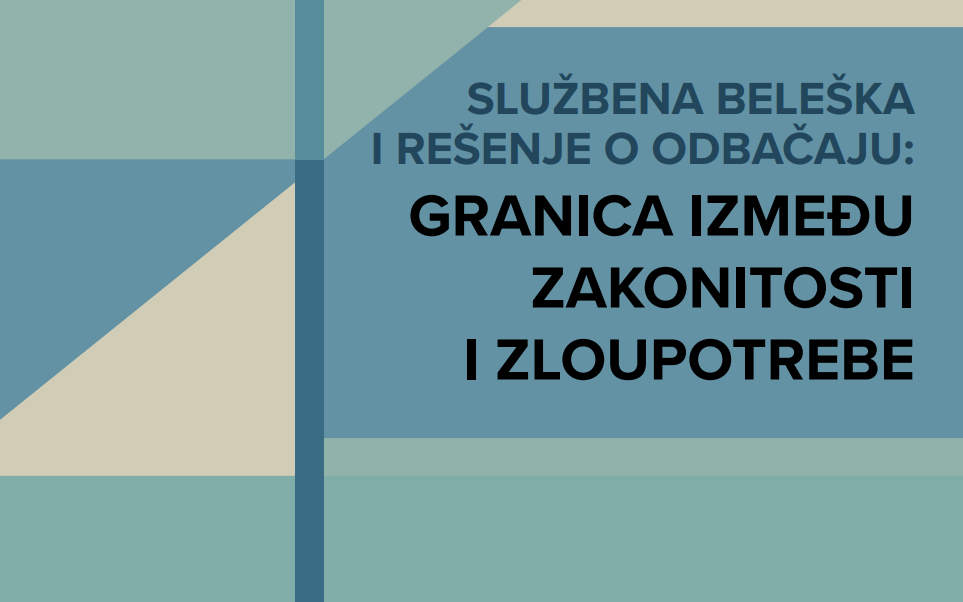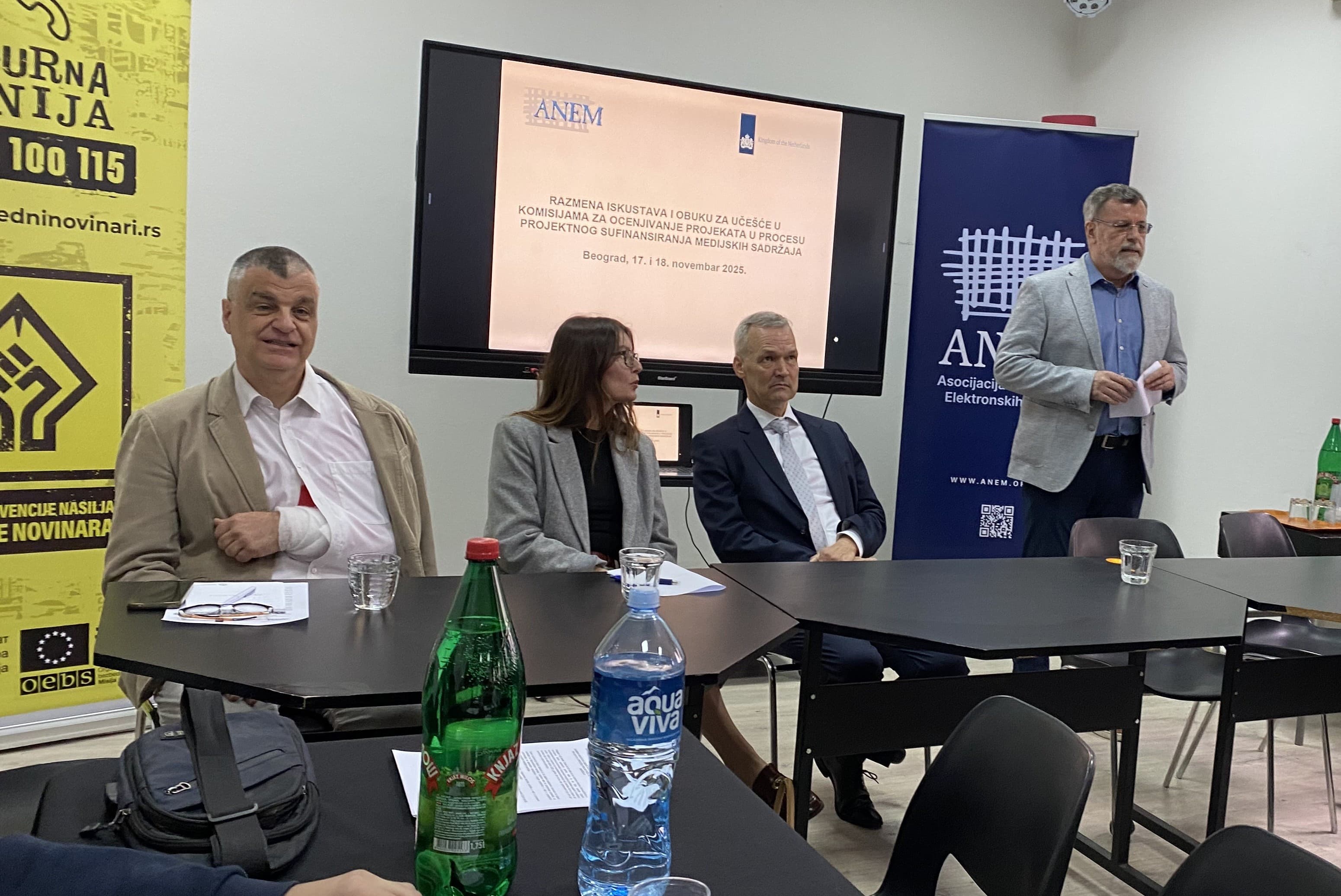The Safety of Journalists at the Local Level: The Case of Sonja Kamenković
"I started looking over my shoulder on the street and avoiding going out after dark. My son was six years old at the time, and it was difficult to explain to him why the police visited us every day. He would go out to play in front of our building, and I would watch him, thinking that if someone really wanted to harm us, they could do so by hurting my child. I reduced both my outings and his, limiting our life to only what was absolutely necessary. The fear grew in me and in my entire family. As time went on, it became increasingly difficult – not just for me, but for my loved ones as well."

Journalist N1 Sonja Kamenković worked as a correspondent for TV B92 in 2010 and lived in Zaječar. At that time, she reported on an incident in Donji Milanovac, where a police officer from Majdanpek, Radomir Radović, who was off duty at the time, entered a local bakery and attacked young men who were present. He beat one of them and broke his arm, while according to eyewitness accounts, he shoved a gun in the mouth of another. “I went to Milanovac and found the injured young man and witnesses. I recorded them; I protected the identities of some because my colleagues from that town told me that the police officer was known for brutality, threats, and abuse of power,” says Sonja Kamenković for “Vreme.” “I tried to get his statement as well, but he did not respond to my calls and messages. I also directed questions to the police in Majdanpek.”
FROM REPORTING TO THREATS
After the segment aired on B92, and articles were published in daily newspapers, the first reactions followed. “A colleague from Majdanpek called me and said that Radović was very angry and that he warned he would kill all the journalists who reported on the case,” recalls Sonja Kamenković. Initially, she did not take those words seriously. However, just a day later, the mother of the injured young man conveyed to her that the police officer had threatened both her and her son for giving statements to B92. “I went back to do a segment about the threats, but neither the mentioned police officer nor the Majdanpek police wanted to comment. The segment was aired in the B92 news.”
After that, Sonja Kamenković began receiving calls from everyone she had been in contact with while working on the story. “Everyone told me the same thing – we met Radović, he said he would kill all the journalists who spread lies about him, that he would come to Zaječar, that he knew where I lived, where to find me, and that he would kill me. I had Radović’s mobile number, but I blocked him. I continued to work as if nothing was happening.”
POLICE PROTECTION AND PRESSURES
Sonja Kamenković states that she continued to receive goodwill calls from people in Majdanpek who conveyed messages from the police officer and warned her that he was a man with a very bad reputation, prone to threats and harassment, but she still did not feel fear. Soon, the B92 editorial team got involved in the story. “Veran Matić, the then director of B92, called me and scolded me for not reporting the threats. I was told that such threats needed to be reported to both the editorial team and the police, but I was young and believed it was not serious.”
When she went to the Zaječar police department, a serious response followed. She was told to file a criminal complaint against the police officer, who was under the jurisdiction of the Bor police department, that the Zaječar police had already filed a complaint, and that she would be assigned 24-hour protection due to operational knowledge of a serious threat. “I was explained that this measure would last until they were sure the danger had passed. At first, I didn’t know what that exactly entailed, but in practice, it meant that a patrol constantly stood guard in front of my building, and inspectors visited me every morning and evening. When I would go to work or filming, plainclothes inspectors followed me and monitored my every step. Initially, it didn’t bother me, but I had no information – neither whether the police were acting against Radović, nor whether someone was monitoring him.”
The protection lasted for months, and her life completely changed. “I began to look over my shoulder on the street and avoid going out at night. My son was six years old at the time, and it was hard to explain to him why the police visited us every day. He would go out to play in front of the building, and I would watch him, thinking that if someone really wanted to harm me, they could do so by harming my child. I reduced both my outings and his, limiting our lives to only what was absolutely necessary. The fear grew for both me and my whole family. As time went on, it became increasingly difficult – not just for me, but for my closest ones.”
It was particularly absurd when inspectors visiting her home would simply respond with “police” when asked “who is it.” This only increased her unease because Radović was also a police officer, and he could ring the bell and introduce himself that way.
Sonja Kamenković says she went to the police multiple times but did not receive concrete answers. She had strong support from the editorial and legal team at B92. At the same time, she faced additional pressures – not only from Radović but also from institutions. “Two inspectors from the Bor police department came to interrogate me, urging me to withdraw the complaint and disclose the identity of the witnesses. They tried to minimize everything. I refused because the legal team at B92 advised me that I was not obligated to do so.”
After that, another unexpected pressure followed. The criminal complaints she filed, as well as those from the Zaječar police, fell under the jurisdiction of the prosecutor's office in Negotin because Radović was a police officer at the Majdanpek police station, which belongs to the Bor police department. Instead of official proceedings, the prosecutor informally summoned her and “advised” her to come to Negotin for a conversation, explaining that it was “for her own good.” This “friendly” invitation had no official character. When the deadline for the prosecutor's office to decide on the criminal complaints passed, Sonja Kamenković began to inquire about what had happened to them. She knew that Radović had initially been suspended but that he was soon reinstated. Unofficially, she was told at the police station in Zaječar that they learned the prosecutor's office had dismissed their complaint and asked if she had received any notification. She had not – and neither had they.
Thus, the criminal complaints remained without an epilogue. She never received an official notification from the prosecutor's office, and unofficially learned that they had been dismissed. Police protection was quietly revoked at one point without formal explanation. According to her information, the only consequence for the police officer was a temporary and short-lived suspension, which at that time could last a maximum of six months.
FROM ISOLATED INCIDENT TO SYSTEMIC PRACTICE
From this distance, Sonja Kamenković says that the whole case from 2010 was an isolated incident. “I had trust in the Zaječar police, and I could reach out to them,” she says. “However, things completely changed two years later, with the rise of the Serbian Progressive Party to power in Zaječar.” She recalls that Saša Mirković, the president of the City Assembly, appeared then, openly and directly threatening journalists who did not want to operate as he deemed necessary. Sonja Kamenković states that he personally threatened her by phone, sent associates to intimidate her, attempted to blackmail her, and warned that he would evict her from the city. At the same time, she started her own business, but her contracts were regularly canceled as soon as she secured them. Both Timočka television and radio, under Mirković's control, continuously targeted Sonja Kamenković. “They published segments attacking me, never giving me a chance to respond,” she recalls. The campaign went so far as to fabricate messages in which she supposedly asked for money in exchange for favorable reporting on the government. Those messages were sent to B92 as “evidence” in an attempt to discredit her and force her out of her job.
Mirković’s example was followed by councilors of the ruling majority in the Assembly, who insulted and attacked her, knowing they would not face consequences for such behavior. “Truth and justice became imaginary categories, while lies and injustice became the dominant practice,” says Sonja Kamenković. The attacks lasted for years, and the police, she claims, operated in the interest of the local authorities. “It never occurred to me to report the threats. The institutions were dead, and individuals who might have wanted to help were sidelined.” In 2019, she decided to leave Zaječar. “They managed to ruin my life in that city, but not my professional principles. I came to Belgrade, I now work at N1, and I do not plan to give up.”
“THE SAFETY OF JOURNALISTS NO LONGER EXISTS”
Sonja Kamenković’s experience is not an exception. She says that the safety of journalists in Serbia is systematically undermined. “The safety of female journalists, but also male journalists, no longer exists – unless you work in regime-controlled media. Then everything is allowed, and you are protected. Otherwise, you are on your own. There may be a few honorable individuals in institutions, but they have no space to help.” What remains, she adds, is solidarity. “It is up to my colleagues and me to protect one another, support each other, and speak out loudly about everything that happens to us. Only then can the public become aware of how serious and dangerous the situation is.”
According to her, the danger does not only threaten journalists from independent media but anyone who dares to express an opinion that displeases those in power. “In such a system, anyone can be crushed in an instant. That is the reality we must keep in mind.”
Source: Vreme
Related Articles

"I am not sure what to expect when I go out on the street": Journalist Isidora Kovačević after the court acquitted the man who was posting wanted notices with her image.

NUNS Analysis: Official Notes Instead of Legal Protection – A System That Leaves Journalists Unprotected











